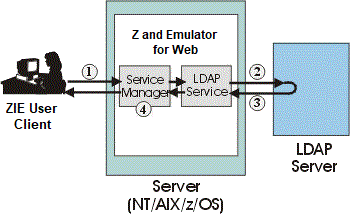 Native Authentication
Native Authentication
 Native Authentication
Native AuthenticationThe native platform authentication service allows users to logon to Z and I Emulator for Web using the same password as they would to logon to the operating system (Windows NT, AIX or z/OS) where Z and I Emulator for Web is active. When a user logs on to Z and I Emulator for Web, their password is validated against the system password, rather than a separate Z and I Emulator for Web password. This gives the Administrator a single point of control for password administration, and the user a single password to remember.
When a user logs on:

 |
To allow users to have passwords with upper case letters, add
LowerCasePasswords = false to the file NSMPROP, located in
the install_directory\lib directory. The service manager reads this file at
startup and uses the LowerCasePasswords parameter to determine password
case. Z and I Emulator for Web uses lower case letters by default. |
Related Topics